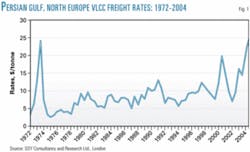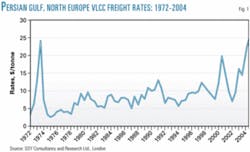Tanker rates soaring as 2004 draws to a close
In only the last few weeks, while an earlier analysis of tanker rates was being prepared for publication and being published ("Higher transport costs drive demand for derivatives," OGJ, Nov. 22, 2004, p. 62), tanker rates have reached the highest they have been since the spikes of the early 1970s, that is, before the oil crises (see chart).
Since mid-October, tanker rates have increased by more than 25% and by 300% since the summer. That earlier article mentioned the current highs: "For example, in May 2004 it was possible to lock-in freight costs for trading 250,000 tonnes of crude from the Middle East to Japan for the rest of the year at about $11/tonne. Today, if a trader wants to do this with the same cargo, it would cost about $36/tonne." In fact, that figure as of mid-November was $45/tonne. And it is worth adding that the current rates are the highest in 30 years: at least $250,000/day on VLCCs trading between the Middle East and Asia Pacific and similar levels to European and American ports.
Hurricanes; OPEC hike
The massive upward hike in rates in the fourth quarter materialized following severe hurricane activity in the US Gulf of Mexico and unusually prolonged after-effects, as charterers came under increasing pressure quickly to cover their transportation requirements ahead of the rising freight trend.
In early November, freight rates also received a boost from the rise in official output quotas for the Organization of Petroleum Exporting Countries of an additional 1 million b/d, which translated into more cargoes available at a time of extremely buoyant oil demand.
Higher levels of oil demand are being felt worldwide, although at present it is the expanding Chinese market that is proving the single most important influence on the change in crude tanker freight rates. This is because of the voyage distance between China's primary source of crude (Middle East Persian Gulf) and importing terminals, thus tying up the tankers for longer periods.
Preliminary data suggest that Chinese crude oil imports have grown by an average of 33% (600,000 b/d) in 2004. US crude imports, meanwhile, have risen by 4% (400,000 b/d) on average this year.
The surge in oil trade has led to an estimated 6% growth in crude tanker demand in 2004 and further growth (of at least 2%) is likely for 2005. This continued rise in tanker demand will keep upward pressure on shipping freight rates in the near term, although charterers will be closely monitoring the large number of ship deliveries expected over the next 3 years.
While this should help ease the tanker demand-supply balance for vessel charters and lead to softer freight levels compared to 2004, volatility in freight rates will continue as long as oil supply concerns persist and oil demand in markets East and West grows.

